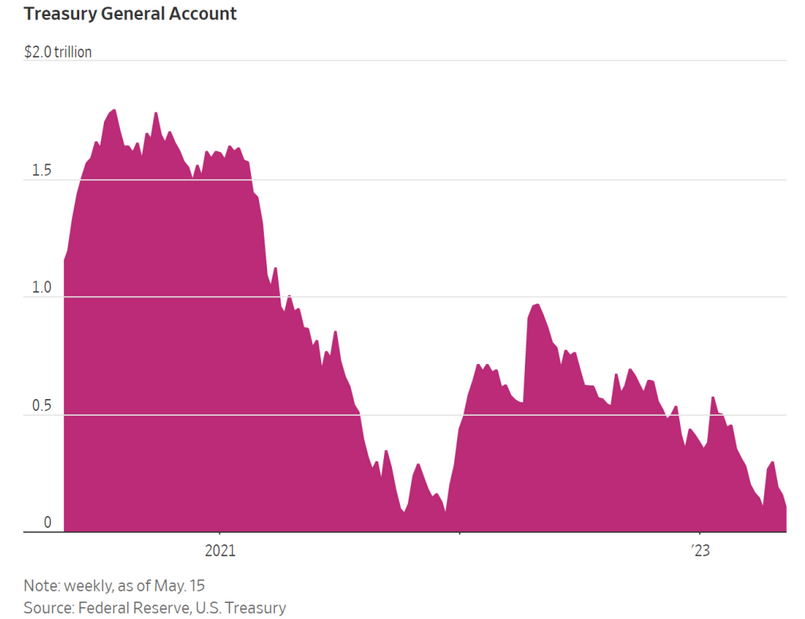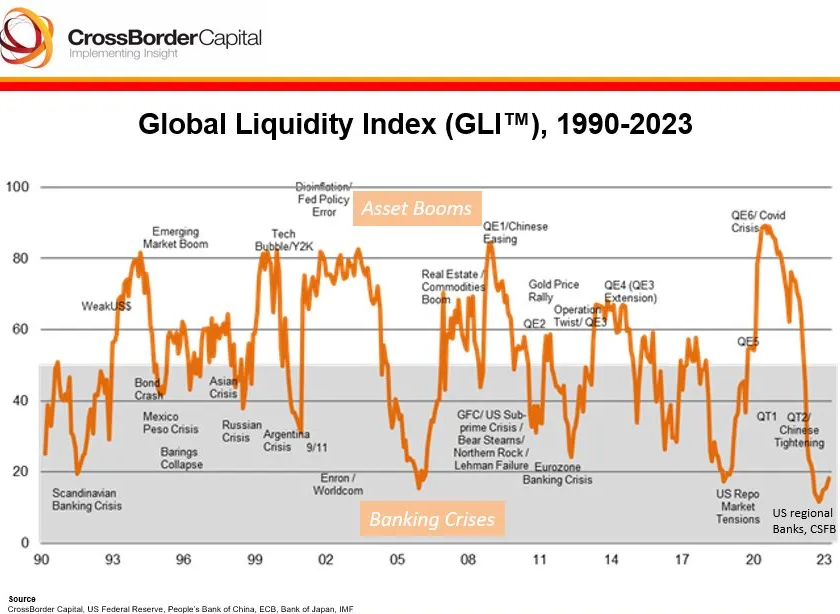Over the last few months, the debt ceiling topic has dominated mainstream media.
And for good reason.
But let’s assume the debt ceiling’s going higher – even if it’s at the last second.
Is that the end of all problems?
Well, it is in the sense that the U.S. won’t default on payments.
But it has its own set of potential consequences that may come with it.
I’m referring to the liquidity drain that’ll happen when the U.S. Treasury raises the debt ceiling, sucking out a massive amount of dollars as they issue bonds. And it’s occurring at a time when the banking sector has grown increasingly fragile and global liquidity is sinking.
I wrote about this same issue back in August 2019. And one month later, the Federal Reserve lost control of the Fed Funds Rate (FFR) as bank liquidity dried up (aka the ‘September Squeeze’ event).
And while I understand that things are different today. There’s still potential for unintended consequences. Especially now as global liquidity continues evaporating.
So, let’s take a closer look at this important – yet little talked about – topic. . .
As The Treasury Refills Its Coffers, Liquidity Drains From The Banking System
Fredric Bastiat – the 19th-century French economist – once wrote about the difference between the ‘good’ economist and the ‘bad’ economist.
Simply put, Bastiat believed that the ‘good’ economist looks beyond the immediate and apparent outcomes to try and forecast the hidden consequences (aka what’s not seen). While the ‘bad’ only looks at the immediate effects and ignores what may follow later (aka what’s seen).
And while this is an important concept, you may be wondering, “Why does this matter?”
Well, because as the mainstream media focuses on the debt ceiling (the seen), it’s critical to look at potential issues it may cause in the U.S. bank sector’s plumbing (the unseen).
For starters, the U.S. Treasury’s general account (aka TGA, basically the government’s savings account held at the New York Fed) is sitting at just $87 billion as of Monday. Down from $140 billion the day before. And well below the Treasury’s targeted year-end balance of $600 billion.

The TGA’s bleeding cash quickly to pay for things like Social Security, Medicare, Federal payrolls, interest on debt, etc.
Thus the Treasury will most likely raise the debt ceiling, allowing it to issue a massive amount of bonds in return for cash.
But here’s where things get tricky. . .
When the U.S. Treasury issues debt, it’s borrowing dollars from primary banks – the biggest of the big banks – as they buy these bonds with surplus cash/reserves (they’re essentially forced to).
Thus – dollars flow out from the primary banks and into the TGA.
So – for example – when the Treasury raises cash through issuing bonds, this reduces reserves in the banking system one-for-one. Meaning a $10 billion increase in the Treasury account immediately drains $10 billion in primary bank reserves (and vice versa when the Treasury spends money).
Now, eventually, these primary banks sell these bonds to the broader financial markets. Such as pension funds, institutional investors, foreign entities, etc.
But they do it slowly (it’s difficult to find $500 billion worth of buyers overnight without affecting liquidity).
Thus the Treasury’s cash grab is effectively pulling reserves out of the banking system by converting them into Treasuries for investors.
And as a result, the available reserves in the banking system decline, which can influence the liquidity and lending capacity of banks.
And that – I believe – is the real unseen problem here.
Because global liquidity has already drained steadily over the last 15 months. And any further decline only increases fragility. . .
A Perfect Storm: Three Factors Making The Treasury’s Cash Grab An Issue
Now, normally the Treasury issuing debt shouldn’t be that big of an issue – but there are three important things to consider this time:
1. The U.S. Treasury is going to raise a substantial amount of cash to refill its coffers.
According to the Treasury Department – the TGA should soar to $550 billion at the end of June (once the debt ceiling’s lifted).
And some estimates show that the Treasury will need to raise over $1 trillion by the end of the third quarter in 2023 to pay obligations.
This is a massive amount of liquidity sucked out of an already fragile banking system.
And this sudden cash grab will likely intensify global funding issues.
Or – putting it simply – it’ll suck a significant amount of U.S. dollars out of the banking system. Further tightening financial conditions.
For instance, Bank of America (NYSE:BAC) estimates it would have the same economic impact as a 0.25% interest-rate hike.
It’s almost like you can hear the sound of a sponge sucking up all this liquidity. . .
2. U.S. bank reserves (aka excess cash held) have already dropped by $930 billion between December 2021 and April 2023 – a 23% decline.

Things like the Fed’s aggressive tightening (through quantitative tightening and rate hikes) and depositors rotating into money-market funds (MMFs) for higher yields have pulled reserves out of the commercial banking system.
And while there’s still $3.2 trillion in bank reserves, the drop was substantial in year-over-year terms.
Thus the Treasury will suck out more cash at a time when bank reserves are already becoming scarce.
This will most likely increase fragility in the funding markets – which is the heart of the credit system and financial sector.
3. Global liquidity has plunged over the last year amid aggressive monetary tightening around the world.
To put this into perspective – according to CrossBorderCapital – global liquidity has plunged to dangerously low levels over the last year.

The world went from essentially 13 years of easy money (2008-2021) and to a rapid tightening cycle in 2022-23.
And as liquidity dried up, so did economic growth and financial stability.
This became clear with the recent U.S. regional bank runs – leading to three of the largest U.S. bank failures ever – Silicon Valley Bank, New York Signature Bank (OTC:SBNY), and First Republic Bank (OTC:FRCB).
To highlight this point, the International Monetary Fund (IMF) noted in April that “the sudden failures of Silicon Valley Bank and Signature Bank in the United States, and the loss of market confidence in Credit Suisse, a global systemically important bank (GSIB) in Europe, have been a powerful reminder of the challenges posed by the interaction between tighter monetary and financial conditions and the buildup in vulnerabilities. . .”
The point here is that global liquidity has dried up sharply over the last year. And it’s caused greater systemic fragility.
And any more vanishing liquidity will only deepen the cracks. . .
In Conclusion
It’s become clear that the markets and banks have grown increasingly fragile over the last year on the back of aggressive monetary tightening.
Bank reserves have fallen sharply. Global liquidity has plunged. And growth has slowed.
Thus the Treasury’s massive cash grab is happening at an unfavorable time.
And I believe it will only amplify any stress by sucking further liquidity out of the financial system.
So, while everyone’s busy focusing on the debt-ceiling talks (what’s seen), I’d rather pay attention to the potential consequences that may ripple from it (the unseen).
Who knows, maybe this won’t even matter.
But at times like this, I remember ‘Murphy’s law’ – which states that “anything that can go wrong, will go wrong.”
Beware.
